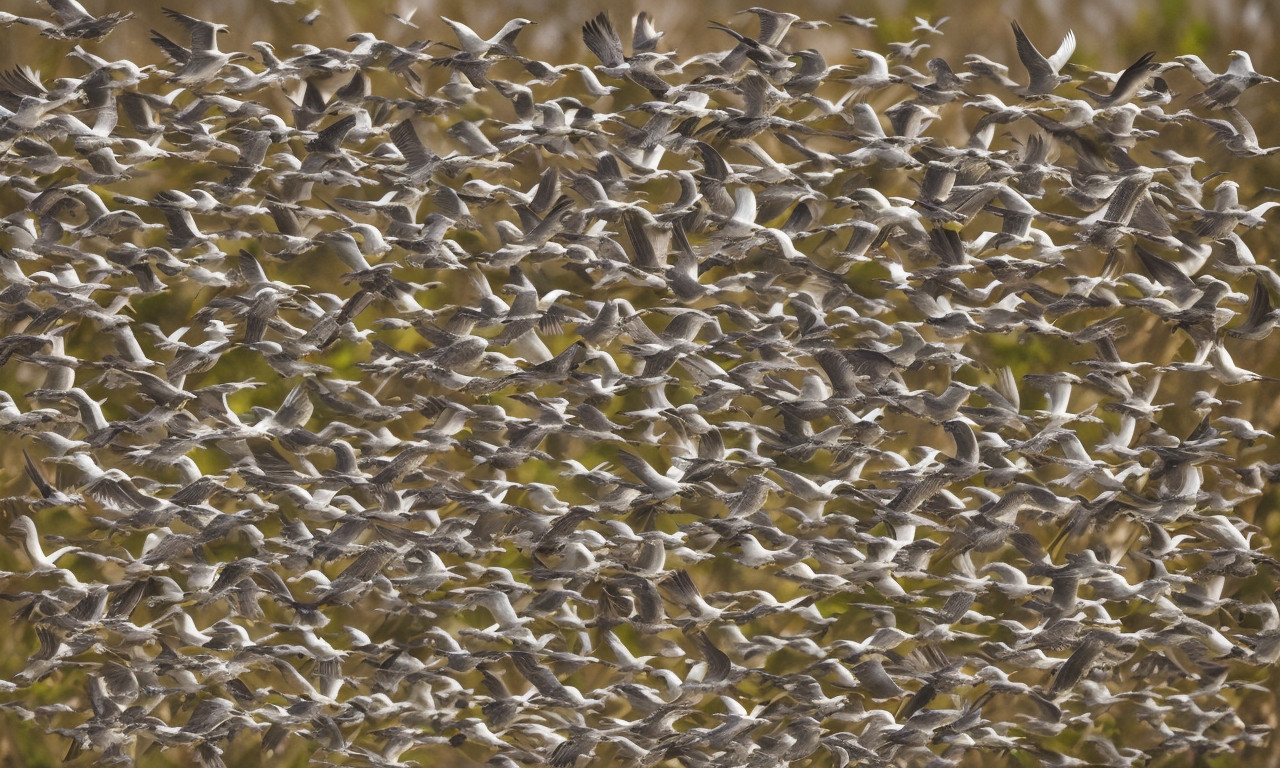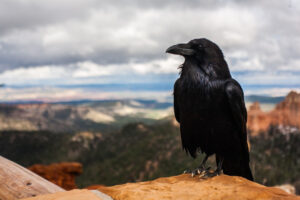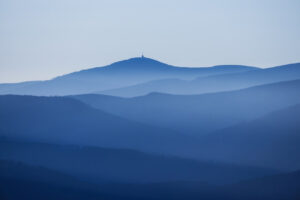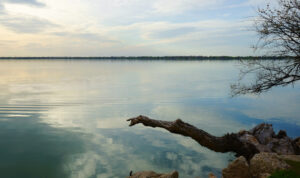The United States is a vast tapestry of habitats and ecosystems, providing a home to an impressive variety of birdlife that can lighten any enthusiast’s heart. From the East Coast to the West, each backyard has the potential to become a miniature sanctuary where the harmonious flutters and melodious calls of birds are a common and delightful occurrence. Whether you’re a seasoned birdwatcher or just a curious observer, the sights and sounds of these winged wonders can offer you a serene escape from the bustle of daily life.
The joy of birdwatching is not merely in the rarity of sighting but appreciating the common species that frequent our environments. These are the birds that comprise the ornithological backdrop to our lives, often overlooked yet essential to the ecosystems they inhabit. In this exploration, we invite you to familiarize yourself with 15 common birds that grace the American skies, gardens, and woods—each a spectacle of nature’s brilliance.
Northern Cardinal: The Crimson Songster
Scientific Name: Cardinalis cardinalis
Identifying the Northern Cardinal
The Northern Cardinal is a familiar sight for many, thriving in a diverse array of environments—from wooded areas to suburban backyards. Characterized by their vibrant red plumage, the males are particularly conspicuous, while the females sport a more subdued, yet elegant, shade of brown tinged with reddish highlights.
Related article; national birds of usa
Enjoying Cardinal Visits
- Provide sunflower seeds in feeders
- Plant native shrubbery for nesting
- Ensure a year-round water source
Cardinals are non-migratory, ensuring their bright presence throughout the seasons, and they often herald the dawn with their tuneful whistles—a song of reassurance that beauty persists in the natural world.
Related article; The Eagles of USA
American Robin: The Early Bird of Spring
Scientific Name: Turdus migratorius
Recognizing an American Robin
Marked by their warm, orange-bellied and slate-gray upper part, American Robins are a sign that spring is near. These ground foragers can be spotted hopping across lawns in search of earthworms, a behavior that has become synonymous with a verdant spring landscape.
Related article; USA’s Birds of Prey
Attracting Robins to Your Garden
- Maintain a patch of open soil for foraging
- Plant fruit-bearing trees and bushes
- Supply a bird bath for splashing and drinking
Investing in such bird-friendly features will not only enrich your local bird life but will also provide you with a living tableau of avian activity throughout the changing seasons.
Related article; of The Most Beautiful Birds of America
Mourning Dove: The Gentle Soother
Scientific Name: Zenaida macroura
Spotting the Mourning Dove
Soft gray in color, with delicate black spots and a distinctive mournful coo, Mourning Doves are fixtures of both rural and urban landscapes. They are often found perched atop telephone wires or foraging on the ground for seeds.
Related article; best birds as pets in los angeles
Encouraging Mourning Dove Visits
- Scatter millet or cracked corn on the ground
- Install platform feeders for easier access
- Plant dense trees for roosting and safety
Their serene presence and soothing calls underscore the quiet moments of daybreak and twilight, offering a peaceful retreat into nature.
Related article; best birds as pets in USA
Blue Jay: The Forest’s Bold Defender
Scientific Name: Cyanocitta cristata
Observing the Blue Jay
The striking Blue Jay, with its brilliant blue crest and noisy calls, is a vigilant protector of its territory. Intelligent and adaptable, these birds can be identified by their unmistakable appearance and their complex social behaviors.
Related article; best bird seed for wild birds
Making Your Yard Welcoming for Blue Jays
- Offer a variety of foods, including nuts and seeds
- Leave natural wooded areas intact for exploration
- Respect their territorial nature, avoiding close encounters
Understanding and respecting the nature of these audacious birds can yield a fascinating glimpse into their world, full of dynamics and hierarchy.
Related article; best pet birds for beginners
Black-capped Chickadee: The Curious Acrobat
Scientific Name: Poecile atricapillus
Getting to Know the Black-capped Chickadee
A tiny bundle of energy, the Black-capped Chickadee is easily recognized by its diminutive size, black cap and bib, along with its friendly “chick-a-dee-dee-dee” call. Its acrobatic feats, as it dangles from twigs and branches in search of insects, are a joy to observe.
Bringing Chickadees Closer
- Stock tube feeders with black oil sunflower seeds
- Cultivate a mix of dense trees and shrubbery for shelter
- Avoid using pesticides to maintain a healthy insect population
Fostering conditions that appeal to chickadees’ natural instincts will encourage these spirited birds to view your backyard as a year-round haven.
House Sparrow: The Ubiquitous Companion
Scientific Name: Passer domesticus
Recognizing the House Sparrow
House Sparrows are familiar beings in urban settings, often seen flitting around park benches and café terraces, their chirps intermingling with the sounds of the human hustle and bustle. They have stout bodies, with males displaying a combination of gray and rusty tones and females clothed in more muted hues.
Coexisting with Sparrows
- Embrace their presence, as they adapt to human surroundings
- Provide easily accessible feeders with mixed seed
- Accept their resourcefulness in both natural and constructed environments
These resilient birds have entwined their existence with ours, mirroring the ebb and flow of our daily lives.
Red-winged Blackbird: The Marshland’s Watchguard
Scientific Name: Agelaius phoeniceus
Identifying the Red-winged Blackbird
Primarily inhabiting wetlands and marshes, Red-winged Blackbirds are impossible to miss with the males’ glossy black feathers and striking red and yellow shoulder patches. The females prefer a more camouflaged look, with streaky brown plumage.
Making Habitats for Red-winged Blackbirds
- Preserve nearby wetlands and water sources
- Allow tall grasses and cattails to grow for nesting
- Reduce pesticide use to keep insect populations healthy
These birds are a vibrant testament to the ecological importance of preserving our natural waterways and marshlands.
American Goldfinch: The Fluttering Wild Canary
Scientific Name: Spinus tristis
Spotting an American Goldfinch
With their bright yellow feathers and cheerful song, the American Goldfinch is often referred to as the "wild canary." They show a fondness for open fields and gardens where thistles and other seeds abound.
Attracting Goldfinches with Seed-Filled Landscapes
- Plant thistle, milkweed, and other seed-bearing flowers
- Use fine mesh feeders stocked with nyjer seeds
- Avoid using chemicals on lawns to encourage natural food sources
Observing the lively goldfinch flocking to these provisions will bring a flash of brilliant color and exuberance to any outdoor space.
Common Grackle: The Iridescent Opportunist
Scientific Name: Quiscalus quiscula
Getting to Know the Common Grackle
Marked by its glossy, iridescent body and piercing yellow eye, the Common Grackle is a resourceful forager with a diverse diet. These birds can often be seen strutting confidently across lawns and parks, their distinctive tail long and keel-shaped.
Fostering Grackle Visitation
- Leave out mixed grains and leftover kitchen scraps
- Maintain open areas of grass for foraging
- Appreciate their adaptability and varied vocalizations
Grackles may have a mixed reputation, but their survival skills and unique character make them a noteworthy addition to the neighborhood wildlife.
Song Sparrow: The Persistent Melodist
Scientific Name: Melospiza melodia
Listening for the Song Sparrow
Song Sparrows are easy to overlook visually, but their tunes are pure and incessant, a complex series of chirps and trills that can last for seconds at a time. These small birds wear a streaked coat of earthy browns and grays, blending magically with their preferred brushy habitats.
Tempting Song Sparrows into your Vicinity
- Leave brush piles and dense vegetation for nesting
- Offer a variety of seeds and small fruits
- Provide a fresh water source for bathing and drinking
By encouraging these music-makers, you’ll ensure a daily concert right in your own backyard.
House Finch: The Rosy Resident
Scientific Name: Haemorhous mexicanus
Recognizing the House Finch
The male House Finch is a petite bird with a charming red head and breast, while females don a modest, streaked brown appearance. They’re gregarious and can be found in loud clusters, often around human habitations where food is plentiful.
Hosting House Finches
- Set up feeders with sunflower seeds or millet
- Plant fruiting trees or vines for natural foraging
- Enjoy their social behavior and lively demeanor
These birds are a spirited presence, adding a dash of color and charisma to any feeder or fruit-bearing flora.
White-breasted Nuthatch: The Upside-Down Forager
Scientific Name: Sitta carolinensis
Spotting the White-breasted Nuthatch
This bird is a compact, agile forager, recognizable by its habit of creeping headfirst down tree trunks. Their white underparts contrast with a cap of black or gray, depending on the sex, and they have a charming nasal call often heard in mature woods or groves.
Encouraging Nuthatch Exploration
- Offer unsalted nuts and sunflower seeds in feeders
- Preserve mature trees with plenty of bark for insect hunting
- Create a natural garden space with minimal human disturbance
Their gravity-defying antics provide endless entertainment and underscore the diversity of feeding behaviors among common birds.
Downy Woodpecker: The Miniature Drummer
Scientific Name: Picoides pubescens
Discovering the Downy Woodpecker
The Downy Woodpecker is the smallest woodpecker in North America, adorned with a black-and-white checkered back and a distinct red patch on the male’s nape. Their rapid-fire drumming and soft calls are a staple of their presence in wooded areas and parks.
Drawing Downy Woodpeckers Closer
- Put up suet feeders for a high-energy food source
- Maintain dead limbs on trees for natural foraging habits
- Plant berry-producing shrubbery for additional food options
These diminutive, yet industrious birds add a layer of dynamism to any habitat they inhabit.
Northern Flicker: The Ground-Dwelling Woodpecker
Scientific Name: Colaptes auratus
Understanding the Northern Flicker
Unlike its tree-tapping cousins, the Northern Flicker prefers hunting insects on the ground, exhibiting a stunning pattern of black spots, bars, and crescents against a backdrop of brown. The underwing and tail feathers flash a bright yellow or red, depending on the subspecies.
Making Space for Flickers
- Leave ant hills and insect-laden areas undisturbed
- Avoid using insecticides which can reduce their food supply
- Place a birdbath nearby as they are particularly fond of bathing
Their unusual foraging behavior and vivid coloration provide an unexpected twist to the usual woodpecker narrative.
European Starling: The Shimmering Socialite
Scientific Name: Sturnus vulgaris
Identifying European Starlings
While regarded by some as a nuisance, the European Starling is undeniably a sight to behold with its metallic, speckled plumage that shines in the sunlight. These birds thrive in groups and their mimicry of various sounds and calls can be utterly fascinating.
Living in Harmony with Starlings
- Provide ample food sources, as they are not picky eaters
- Accept that they may displace native species, understanding their role in our ecosystem
- Learn to appreciate their complex social structures and communication
While they may create challenges for native species, their resourcefulness and adaptability are hallmarks of their success across various landscapes.
Cedar Waxwing: The Sleek Berry Lover
Scientific Name: Bombycilla cedrorum
Finding Cedar Waxwings
The Cedar Waxwing, with its sleek, crested appearance and black eye mask, is a social bird often found in large flocks. They have a particular fondness for fruit, which makes up the majority of their diet.
Berry Buffets for Waxwings
- Plant native berry-producing bushes and trees
- Provide a steady water source for hydration and bathing
- Refrain from pruning berry bushes until after the berries have been consumed
By catering to the waxwing’s diet, one can witness the harmony of numerous birds convening for a feast—an illustration of nature’s communal dining.
In the quest to welcome these birds, planting native species, maintaining bird-friendly spaces, and providing diverse food and water sources are essential. The symphony of songs and feathered, darting visual delights they bring to our lives enriches our experience of the world around us. As we embrace these common birds of the USA, we not only gain a deeper appreciation for their individual charms, but we also contribute to their conservation and the well-being of our shared environment.




